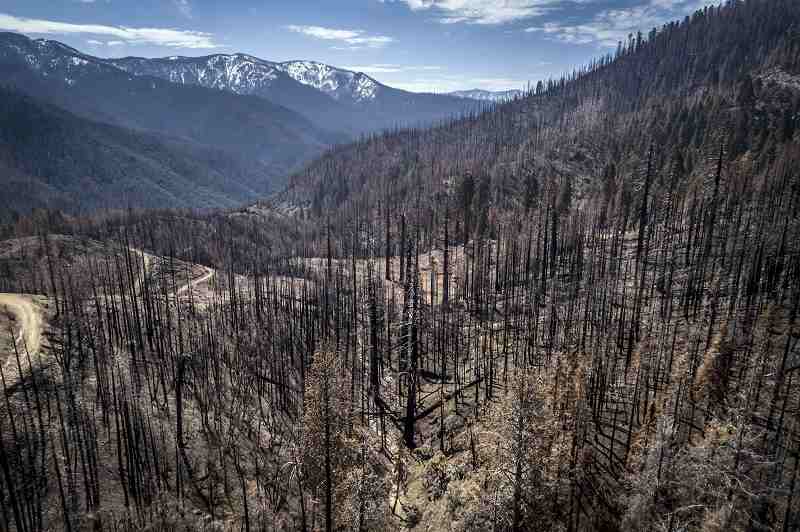
A burned hillside where crews are planting seedlings including Giant Sequoia in Mountain Home State Demonstration Forest outside Springville, Calif., on April 26, 2022.
12:00 JST, July 26, 2022
BILLINGS, Mont. (AP) — The Biden administration on Monday said the government will plant more than one billion trees across millions of acres of burned and dead woodlands in the U.S. West, as officials struggle to counter the increasing toll on the nation’s forests from wildfires, insects and other manifestations of climate change.
Destructive fires in recent years that burned too hot for forests to regrow naturally have far outpaced the government’s capacity to plant new trees. That has created a backlog of 4.1 million acres (1.7 million hectares) in need of replanting, officials said.
The U.S. Agriculture Department said it will have to quadruple the number of tree seedlings produced by nurseries to get through the backlog and meet future needs. That comes after Congress last year passed bipartisan legislation directing the Forest Service to plant 1.2 billion trees over the next decade and after President Joe Biden in April ordered the agency to make the nation’s forests more resilient as the globe gets hotter.
Much of the administration’s broader agenda to tackle climate change remains stalled amid disagreement in Congress, where Democrats hold a razor-thin majority. That has left officials to pursue a more piecemeal approach with incremental measures such as Monday’s announcement, while the administration considers whether to declare a climate emergency that could open the door to more aggressive executive branch actions.
To erase the backlog of decimated forest acreage, the Forest Service plans over the next couple years to scale up work from about 60,000 acres (24,000 hectares) replanted last year to about 400,000 acres (162,000 hectares) annually, officials said. Most of the work will be in western states where wildfires now occur year round and the need is most pressing, said David Lytle, the agency’s director of forest management.
Blazes have charred 5.6 million acres so far in the U.S. this year, putting 2022 on track to match or exceed the record-setting 2015 fire season, when 10.1 million acres (4.1 million hectares) burned.
Many forests regenerate naturally after fires, but if the blazes get too intense they can leave behind barren landscapes that linger for decades before trees come back.
“Our forests, rural communities, agriculture and economy are connected across a shared landscape and their existence is at stake,” Agriculture Secretary Tom Vilsack said in a statement announcing the reforestation plan. “Only through bold, climate-smart actions … can we ensure their future.”
The Forest Service this year is spending more than $100 million on reforestation work. Spending is expected to further increase in coming years, to as much as $260 million annually, under the sweeping federal infrastructure bill approved last year, agency officials said.
Some timber industry supporters were critical of last year’s reforesting legislation as insufficient to turn the tide on the scale of the wildfire problem. They want more aggressive logging to thin stands that have become overgrown from years of suppressing fires.
To prevent replanted areas from becoming similarly overgrown, practices are changing so reforested stands are less dense with trees and therefore less fire prone, said Joe Fargione, science director for North America at the Nature Conservancy.
But challenges to the Forest Service’s goal remain, from finding enough seeds to hiring enough workers to plant them, Fargione said.
Many seedlings will die before reaching maturity due to drought and insects, both of which can be exacerbated by climate change.
“You’ve got to be smart about where you plant,” Fargione said. “There are some places that the climate has already changed enough that it makes the probability of successfully reestablishing trees pretty low.”
Living trees are a major “sink” for carbon dioxide that’s driving climate change when it enters the atmosphere, Fargione said. That means replacing those that die is important to keep climate change from getting even worse.
Congress in 1980 created a reforestation trust that had previously capped funding — which came from tariffs on timber products — at $30 million annually. That was enough money when the most significant need for reforestation came from logging, but became insufficient as the number of large, high intensity fires increased, officials said.
Insects, disease and timber harvests also contribute to the amount of land that needs reforestation work, but the vast majority comes from fires. In the past five years alone more than 5 million acres were severely burned.
"News Services" POPULAR ARTICLE
-

American Playwright Jeremy O. Harris Arrested in Japan on Alleged Drug Smuggling
-

Japan’s Nikkei Stock Average as JGB Yields, Yen Rise on Rate-Hike Bets
-

Japan’s Nikkei Stock Average Licks Wounds after Selloff Sparked by BOJ Hike Bets (UPDATE 1)
-

Japanese Bond Yields Zoom, Stocks Slide as Rate Hike Looms
-

Japan’s Nikkei Stock Average Buoyed by Stable Yen; SoftBank’s Slide Caps Gains (UPDATE 1)
JN ACCESS RANKING
-

Keidanren Chairman Yoshinobu Tsutsui Visits Kashiwazaki-Kariwa Nuclear Power Plant; Inspects New Emergency Safety System
-

Imports of Rare Earths from China Facing Delays, May Be Caused by Deterioration of Japan-China Relations
-

University of Tokyo Professor Discusses Japanese Economic Security in Interview Ahead of Forum
-

Japan Pulls out of Vietnam Nuclear Project, Complicating Hanoi’s Power Plans
-

Govt Aims to Expand NISA Program Lineup, Abolish Age Restriction


























